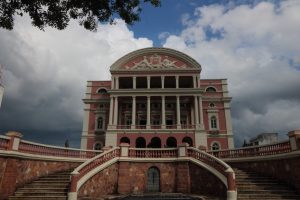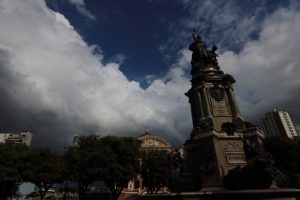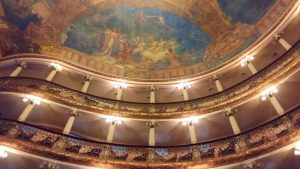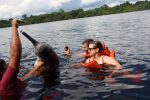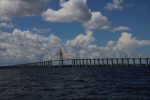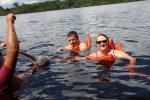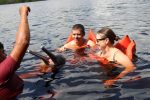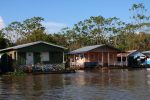We’re back in Brazil. Friendliest country in South America, maybe even on the planet! French Guiana, Suriname and Guyana have been a fascinating, enjoyable de-tour and one that relatively few travellers make when overlanding South America. But Brazil puts them all in the shade when it comes to enthusiastic welcomes. Even when we can’t understand a word they say, Brazilians say it with a big smile and a thumbs-up! Now we’re in far north Brazil wondering what to do next…
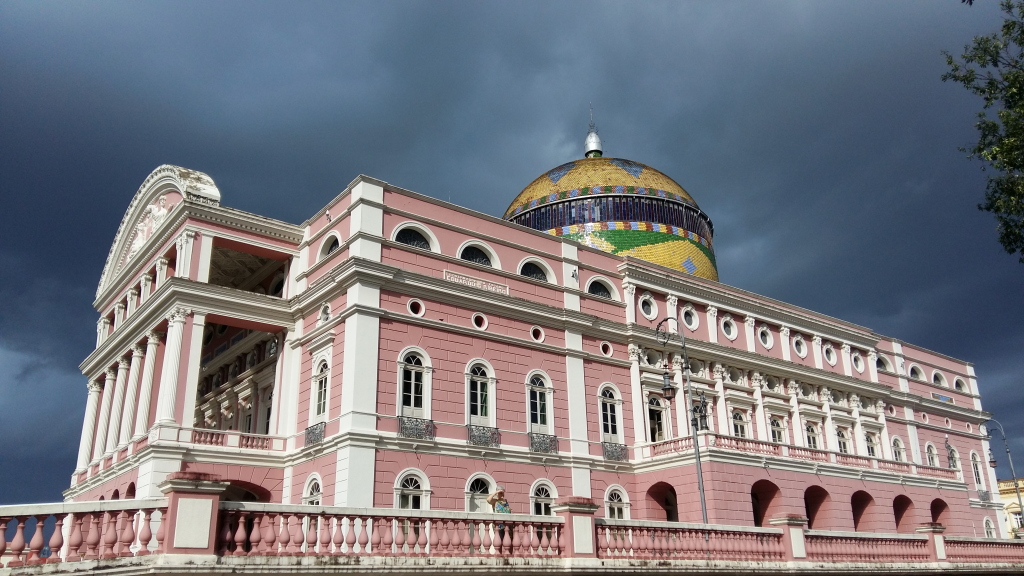
Manaus Opera House – challenging those fancy Europeans!
Venezuela: Optional Excursion
Let’s kick-off with a bit of ‘audience participation’: what would you do? Your final destination in South America will eventually be Colombia. Having left Guyana, you’re sitting at the T-junction town of Boa Vista in north Brazil, with two possible routes to get to Colombia: Option A – turn right to Venezuela, then cross to Colombia (2,750 km); or Option B – turn left to Manaus, across the centre of the Amazon jungle on the notorious BR-319 mud-road, past Rio Branco, into south Peru, then north again through Peru, through Ecuador and up to Colombia (6,600 km).
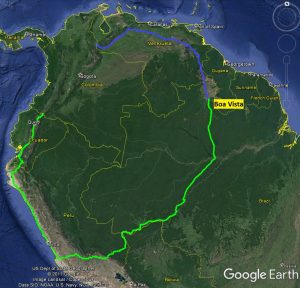
Which route would you choose?
To aid your decision, you might want to know that Venezuela has great scenery and things to see (I can assure you of this as I spent a couple of months there as a student back-packer many years ago). Seems like a ‘no-brainer’, right? The shorter Option A route, surely?
But if you aren’t already up-to-speed on South American news, you might also be interested to learn that Venezuela is in a bit of a pickle right now. It’s bad, and deteriorating rapidly. I haven’t checked recently, but I reckon that El Presidente Maduro probably isn’t getting many ‘likes’ on Facebook at the moment.
Setting aside the news stories that don’t concern overland travellers too much (i.e. tensions and violence in the city centres that you have no intention of visiting) there are two small points that you might want to bear in mind for the Venezuela route. First, the border closures for vehicles. It might spoil your trip if you drive right across the country to the Colombian border only to be waiting weeks to get out. Secondly, food and fuel shortages. Shelves are mostly bare in shops and with almost no fuel available at the pumps, locals are now forced to resort mostly to public transport rather than using their own vehicles. So you might not even reach the Colombian border to find out whether it’s open for vehicles or not.
Hmmm… at this point your choice of Option A might not be looking quite so attractive.
“Aha!” you say, “What about a compromise? How about just driving over the border, doing a quick look-around the southern corner, then coming back into Brazil for Option B Amazon route?” Well yes, that’s do-able. It would be a bit of a ‘box-ticking’ exercise in Venezuela, and you obviously wouldn’t see much of the country, but it’s an option.
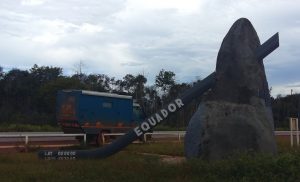
Crossing the equator
Here’s the final piece of information on which to base your decision. On arrival into Brazil from Guyana, the Immigration Officer mistakenly gives you a 90 day allowance to stay in Brazil rather than the 30 days that you should have been given under the rules. You were always concerned that the permitted 30 days would be tight to cover the Amazon route. Now, you have an unexpected three month buffer-zone in Brazil! If you do the south Venezuela ‘box-tick’ and then re-enter Brazil, there is a good chance that you’ll be reverted to your correct allowance of 30 days.
So how is it looking now? Option B maybe? Congratulations! Option B is the right answer! Your prize is in the post 🙂
Keen though I am to re-visit Venezuela, Marcus is equally keen to test Cuthbert on the infamous 870km trans-Amazon mud-road BR-319 from Manaus to Porto Velho. And so it comes to pass, that at the Boa Vista T-junction we turn left, over the Equator and south to Manaus. Venezuela will be there for another trip sometime, hopefully when a regime with a few more ‘likes’ on Facebook holds the reigns.
Manaus
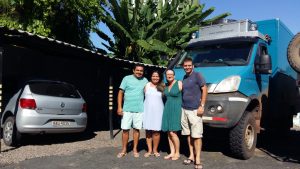
The nicest car-park people!
Back in the southern hemisphere, we’re looking forward to some ‘tourist time’ in the Amazon city of Manaus. Finding places to park-up in cities can be a problem, but in Manaus we find a suitable inner-city car-park (for this you can read ‘convenient location but a less-than-attractive view from the window’ 🙂 ). True to the Brazilian-style welcome and hospitality, the parking-warden is so friendly that he knocks on our door each morning with free coffee and fresh bread for breakfast! Where else in the world do you get that in an inner-city car-park?
Manaus city has a very pleasant old town with colonial architecture dominated by a fabulous pink opera house. It was built in the 19th Century in a French style to challenge the fancy European cultural centres of the time, but it still hosts performances (of some kind or other) almost every day. Out and about, we took a bus-boat down the Amazon to see the surrounding areas. Ingeniously, there are whole communities that have built their homes on floating logs, so no matter how high the water gets, they never flood. Good thinking, huh?
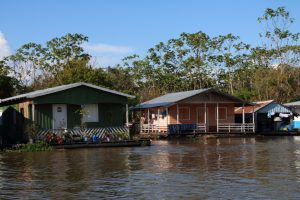
Floating houses
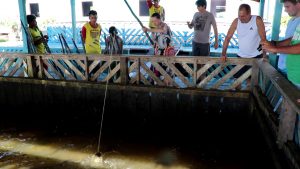
Fighting with a pirarucu
There are quite a few other ‘tourist ticks’ to be visited around the Manaus area, most of which are centred around the Amazon River.One of the river’s many inhabitants is the giant pirarucú fish – a local delicacy and it is indeed rather yummy. Fully grown at over 6 ft long, they’re the biggest fresh-water fish in the world; not easy to catch but at a local fish farm they let you have a go.
Standing on the edge of the fish-pen, you’re given a stick, with a line on which hangs a small fish as bait. The challenge is to hang the bait over the water, wait for a monster pirarucú to leap up to bite, then wrestle with the stick being tugged by the weight of the 6 ft fish writhing on the end of the line. If you land the catch, you get to keep the pirarucú. But there is no hook, only bait on the end of the line! Needless to say, nobody ever lands a catch, but it’s a really fun way to feed fish.
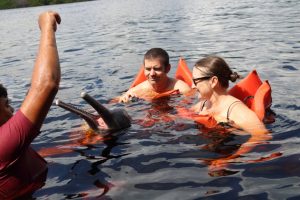 Living alongside the pirarucú in the Amazon are some chummy creatures that just love being visited: the pink dolphins. Unlike the Amazonian grey dolphins which live in family pods and are less sociable with humans, the pink dolphins live more solitary lives away from other dolphins and love the company of humans. Just up-stream from the city is a place where visitors can swim with the pink dolphins in the river… Awww can’t miss that one can we?
Living alongside the pirarucú in the Amazon are some chummy creatures that just love being visited: the pink dolphins. Unlike the Amazonian grey dolphins which live in family pods and are less sociable with humans, the pink dolphins live more solitary lives away from other dolphins and love the company of humans. Just up-stream from the city is a place where visitors can swim with the pink dolphins in the river… Awww can’t miss that one can we?
For conservation purposes, it’s a supervised, controlled activity but it takes place in the open river where the dolphins swim freely. The supervising staff offer a tasty-fishy-snack incentive for the dolphins to gather around, but there is no captivity or enclosures and the dolphins chose for themselves whether to come forward or not. We’re required to wear some flotation aids in the water which is a bit of a pain, but the dolphins come and swim around your legs. They rub their soft, rubbery skin against you, then jump-up to play and receive fish. Awesome.
Next, we’re getting really stuck-in to the depths of the Amazon rainforest, driving right across the middle on the BR-319 mud-road. It’s a notoriously remote, rough and deep-muddy route. Hopefully ‘stuck-in’ will turn out to be a metaphorical rather that our practical experience of the route 🙂
Link to next blog: Driving the BR-319 (with free pants and a soup tin) Link to full South America Blog
Manaus Photos
- Fighting with a pirarucu
- Floating houses
- The nicest car-park people!

